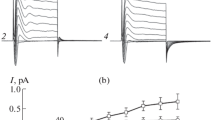Summary
The nephridial nerve cells of the leech, Hirudo medicinalis, 34 sensory cells, each associated with one nephridium, are sensitive to changes in extracellular Cl- concentration, an important factor in ion homeostasis. Using single-electrode current- and voltage clamp and ion substitution techniques, the specificity and mechanism of Cl- sensitivity of the nephridial nerve cell was studied in isolated preparations. Increase of the normally low external Cl- concentration leads to immediate and sustained hyperpolarization, decrease of the frequency of bursts and decrease of membrane conductance. The response is halogen specific: Cl- can be replaced by Br−, but not by organic mono- or divalent anions or inorganic divalent anions.
At physiological Cl- concentrations (36mM extra-cellular Cl-), the nephridial nerve cell has a high resting conductance for Cl- and the membrane potential is governed by Cl-. In high extracellular Cl- concentrations (110–130 mM), membrane conductance is low, most likely due to the gating off of Cl- channels. Under these conditions, membrane potential is dominated by the K+ distribution and the nephridial nerve cell hyperpolarizes towards EK.
Similar content being viewed by others
Abbreviations
- NNC :
-
nephridial nerve cell
- V m :
-
membrane potential
- E Cl(k) :
-
equilibrium potential for Cl (K)
- IV-curve :
-
current-voltage relationship
References
Angstadt JD, Calabrese RL (1989) A hyperpolarization-activated inward current in heart interneurons of the medicinal leech. J Neurosci 9:2846–2857
Boroffka I (1968) Osmo- and Volumenregulation bei Hirudo medicinalis. Z Vergl Physiol 57:348–375
Calabrese RL, Wenning A (1989) Nephridial nerve cells of the leech are sensitive to external Cl- concentration. Soc Neurosci Abstr 15:1289
Hille B (1984) Ionic channels of excitable membranes. Sinauer Ass. Inc., Sunderland, Mass.
Hoeger U, Wenning A, Greisinger U (1989) Ion homeostasis in the leech: contribution of organic anions. J Exp Biol 147:43–51
Kanosue K, Schmid H, Simon E (1990) Differential osmoresponsiveness of periventricular neurons in duck hypothalamus. Am J Physiol 258:R973-R981
Nicholls JG, Kuffler SW (1964) Extracellular space as a pathway for exchange between blood and neurons in the central nervous system of the leech: ionic composition of glial cells and neurons. J Neurophysiol 27:645–671
Nicholls JG, Wallace BG (1978) Quantal analysis of transmitter release at an inhibitory synapse in the C.N.S. of the leech. J Physiol 281:171–185
Purves RP (1981) Microelectrode methods for intracellular recording and ionophoresis. Academic Press, London New York Toronto Sydney San Francisco
Schlauer E, Salomonsson M, Persson AEG, Greger R (1989) Macula densa cells sense luminal NaCl concentration via furosemide sensitive Na+2Cl-K+ cotransport. Pflügers Arch 414:286–290
Wenning A (1983) A sensory neuron associated with the nephridia of the leech Hirudo medicinalis L. J Comp Physiol 152:455–458
Wenning A (1989) Properties of a set of internal receptors in the medicinal leech: the nephridial nerve cells monitor extracellular chloride concentration. J Exp Biol 143:115–132
Wenning A, Cahill MA (1986) Nephridial innervation in the leech Hirudo medicinalis L. Cell Tissue Res 245:397–404
Wenning A, Calabrese RL (1990) Steuerung der Nephridienfunktion im Egel: Funktion und Transduktionsmechanismus eines identifizierten Ionenrezeptors. Verh Dtsch Zool Ges 83 (in press)
Wenning A, Zerbst-Boroffka I, Bazin B (1980) Water and salt excretion in the leech (Hirudo medicinalis L.). J Comp Physiol 139:97–102
Zebe E, Salge U, Weimann C, Wilps H (1981) The energy metabolism of the leech Hirudo medicinalis in anoxia and muscular work. J Exp Zool 218:157–163
Zerbst-Boroffka I (1970) Organische Säurereste als wichtigste Anionen im Blut von Hirudo medicinalis. Z Vergl Physiol 70:313–321
Zerbst-Boroffka I (1973) Osmo- und Volumenregulation bei Hirudo medicinalis nach Nahrungsaufnahme. J Comp Physiol 84:185–204
Author information
Authors and Affiliations
Rights and permissions
About this article
Cite this article
Wenning, A., Calabrese, R.L. Mechanism of Cl- sensitivity in internal ion receptors of the leech; an inward current gated off by Cl- in the nephridial nerve cells. J Comp Physiol A 168, 53–61 (1991). https://doi.org/10.1007/BF00217103
Accepted:
Issue Date:
DOI: https://doi.org/10.1007/BF00217103



